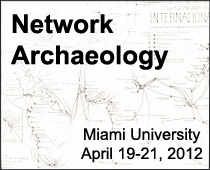Presentation by Liam Young (University of Western Ontario).
This paper examines ‘the list’ as a communicative device and material form. It seeks to map out functional connections between the list and the network as a means by which to more broadly develop a media archaeological approach to studying the formation and operation of power/knowledge networks in human societies.
Two dimensions of the relation between the list and the network are explored specifically. First, the list as network, as a form that draws things together—translating, abstracting, and placing words and things in relation to one another, in both the aesthetic (Eco 2009; Foucault 1970) and politico-economic (Weber 1958; Goody 1977) realms. It is argued that lists function thus as Latour’s (1987) ‘immutable mobiles,’ stabilizing, mobilizing, and combining data. Lists crystallize data as ‘information’ or in material documents that can be used to form networks of power/knowledge that control from a distance. Such activity relates to the second dimension explored: lists function to facilitate various networks of action, both contemporaneous and historical. As examples: contemporaneously, the list is integral to computer programming languages such as LISP, while it may also be a form uniquely suited for future A.I. research (Adam 2008). Historically, lists are frequently implicated in the administration and control of human populations, most heinously in the census and death lists of the Nazi administrative apparatus (Werbin 2008; Aly and Roth 2004). Comparing and contrasting such functional capacities can highlight important ethical dimensions of a seemingly innocuous form of information storage and communication.
A media archaeology of the list such as I propose situates it as an attractor and facilitator of different political, economic, technological and aesthetic networks. The paper seeks to make a contribution that can illuminate the functionality of and relations between the human and nonhuman actants that together are constitutive of—and act within—such networks.
Liam Young is a 2nd year PhD student in Media Studies at The University of Western Ontario in London, Ontario, Canada. His presentation shares aspects of a larger research project, which seeks to make sense of contemporary ‘list culture’ by un-black boxing the various functions of lists throughout history, in a variety of material contexts–political, cultural, aesthetic, technological, etc. He has presented this and other work at numerous conferences over the last several years. He hold an MA in Popular Culture from Brock University, Canada, and two BAs from the University of Calgary (International Relations, and History).





Pingback: Sorting Network Artifacts, Part 1 | Words in Space